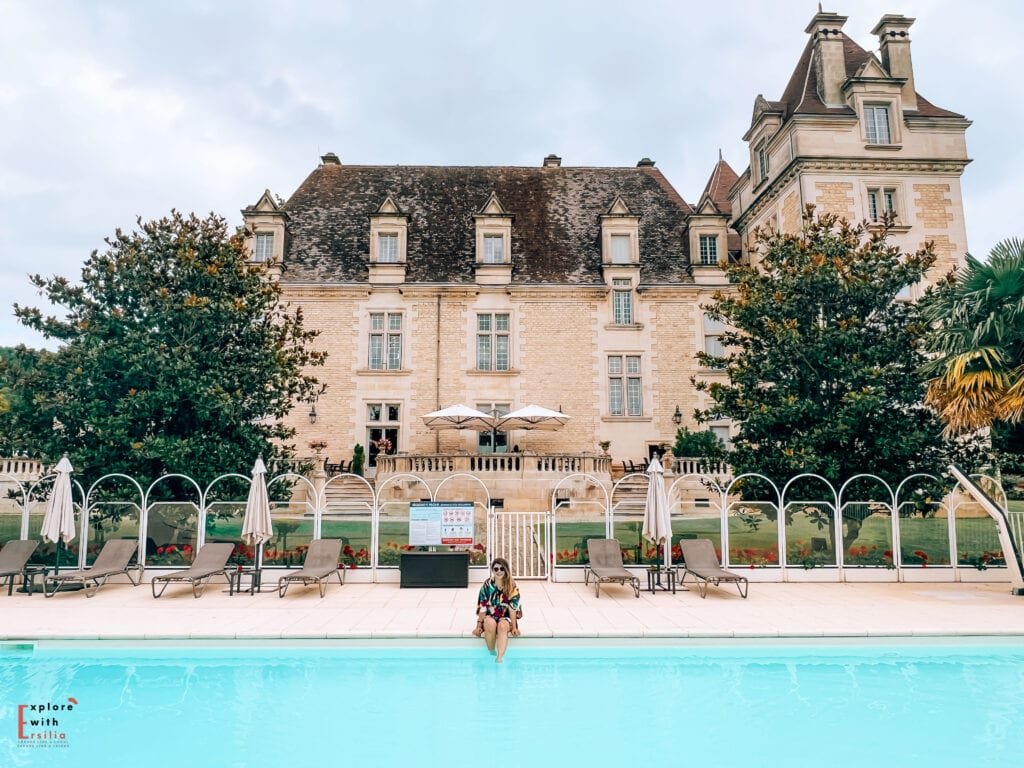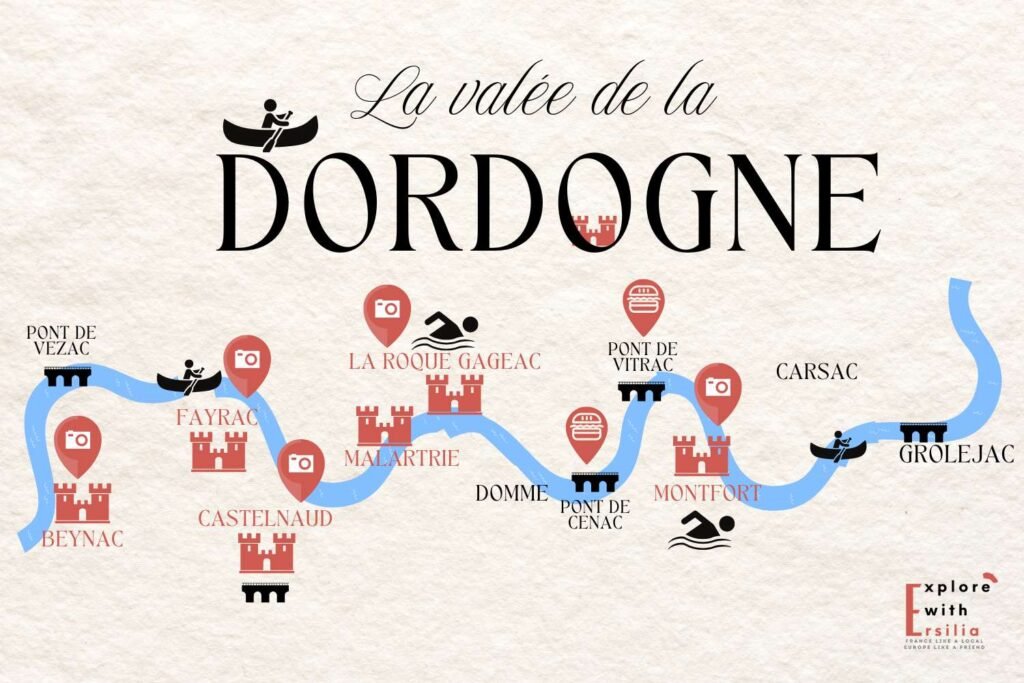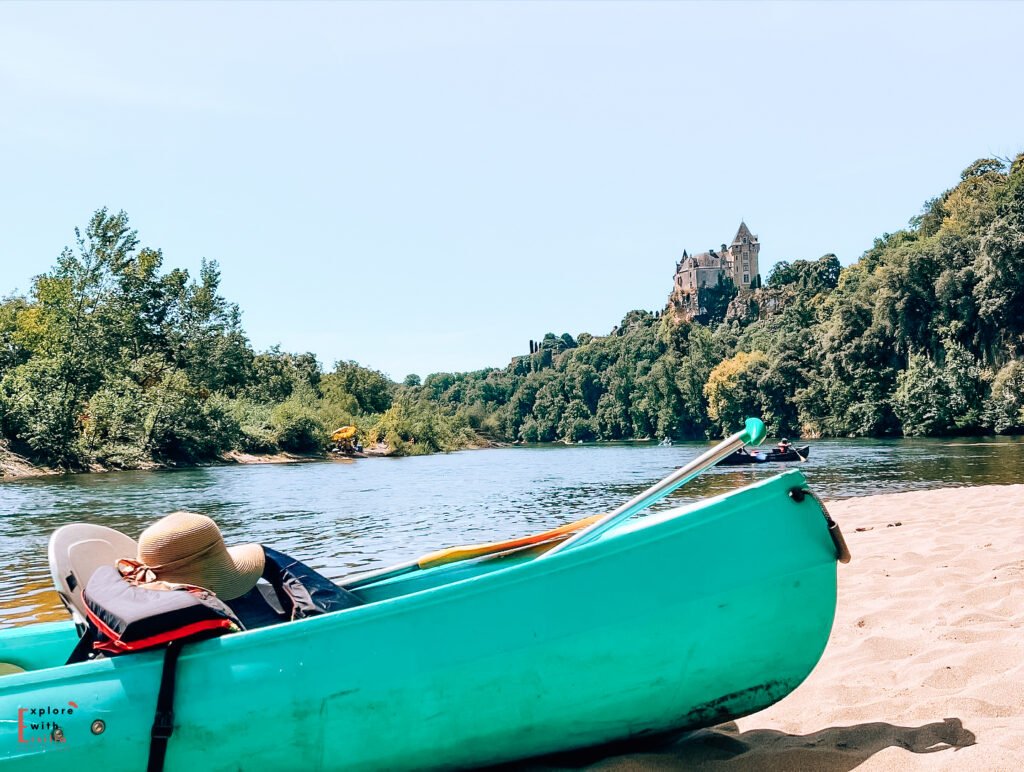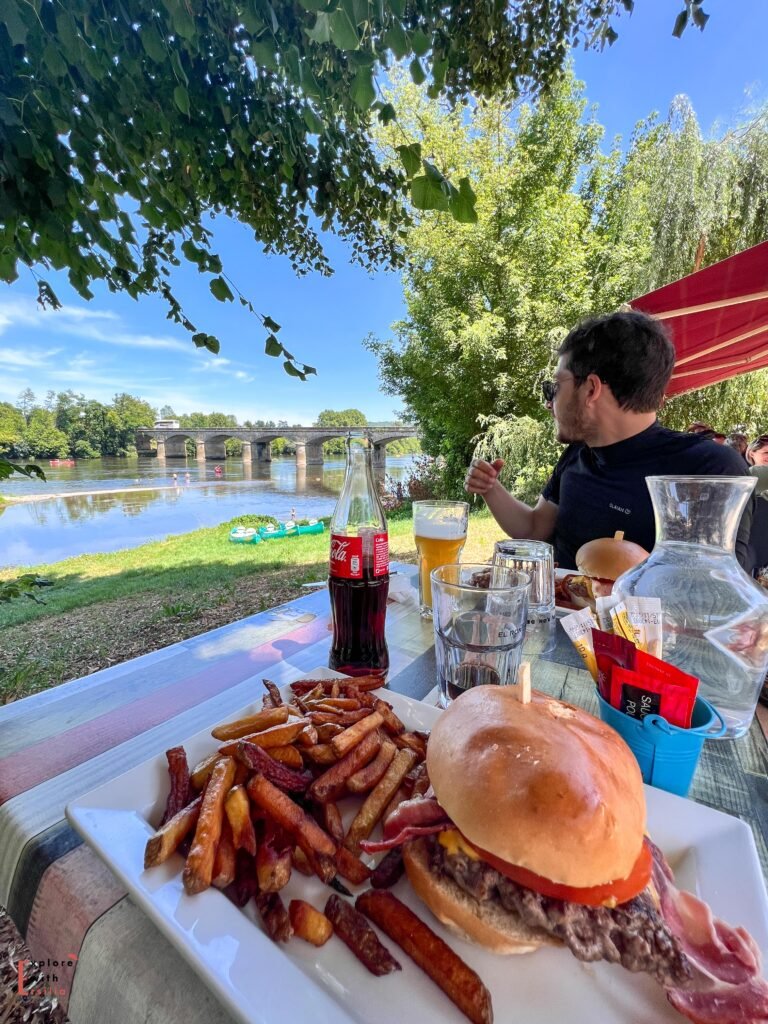Explore with Ersilia contains affiliate links and is a member of the Amazon Services LLC Associates Program. If you make a purchase using one of these links, I may receive compensation at no extra cost to you. affiliate links are how we keep this content free. A huge thanks if you use these as it helps a lot! See the Full Policy for more information.
Did you know that within just 29 kilometers of the Dordogne River, you can paddle past five magnificent medieval castles that have stood guard over these waters for nearly 1,000 years? Welcome to France’s most spectacular kayaking adventure route! I’ve explored this historic waterway multiple times, and I’m excited to share this incredible journey that combines outdoor adventure with living history. From the mighty Château de Beynac to the picturesque village of La-Roque-Gageac, get ready for an unforgettable paddle through time!
Why Kayaking is the Best Way to Experience the Dordogne Valley
Gliding down the Dordogne by canoe offers more than just a day of paddling – it provides a unique perspective on centuries of French history. From the water level, you experience these magnificent castles just as travelers and traders would have seen them hundreds of years ago.
Each stroke of the paddle takes you further along the same routes where medieval merchants, soldiers, and locals once traveled, while the castles above tell their tales of power, rivalry, and survival.
It’s perhaps the most authentic way to understand why this valley, with its strategic river and protective cliffs, played such a crucial role in shaping French history.
While you can visit each castle individually by car, seeing them from the river helps you grasp how they all connected, protected, and controlled this vital medieval waterway.

Planning Your Dordogne Castle Kayaking Adventure
When to Go: Timing Your Perfect Paddle
You know what’s amazing about the Dordogne? While most European destinations have super limited seasons, this magical river valley welcomes paddlers from early May all the way through October!
I’ve done this route in different seasons, and let me tell you – summer is absolutely prime time. The water gets warm enough for impromptu swimming breaks, which trust me, you’ll want after a few hours of paddling!
Where to stay
I absolutely recommend staying close to the river, either in Beynac-et-Cazenac, La Roque Cageac, Dommes. A good option is also Sarlat-la-Caneda that offers a wide range of accomodations and restaurants.
I visited the Dordogne Valley 3 times already, each time staying in another place. My favourite one was the Domaine de Monrecour, located just outside Beynac-et-Cazenac. It offered the perfect base for kayaking, as it was just 3 minutes away from the main action.

Choosing Your Kayak Adventure: Three Epic Routes
Here’s the thing about kayaking the Dordogne – it’s like picking your favorite French cheese. There’s no wrong choice, but each option offers something special! Let me break down these routes for you:
The Discovery Route (8km)
This one’s a gem! After just a few paddle strokes, you’ll find yourself beneath the majestic Château de Montfort, an 18th-century stunner perched on its promontory. I love this route because it gives you plenty of time to take breaks for swimming in the crystal-clear water.
You’ll glide past the dramatic cliffs of Domme village overlooking the river, then along the stunning La Roque Gageac with its fascinating troglodyte houses carved right into the cliffs. The route finishes with views of Château de la Malartrie – not bad for a short paddle, right?
The Picturesque Circuit (15km)
Starting from Carsac near Sarlat, this 2-hour journey from Pont de Grolejac is perfect if you’re bringing kids or want a more relaxed experience. The highlight? Definitely the bend at Montfort with that gorgeous 18th-century château and its impressive ramparts overlooking the river.
This section is actually one of the most untamed parts of the river – I’ve spotted so much wildlife here! There’s this massive island in the river where you can stop for a break, and let me tell you, the views are absolutely spectacular.
You’ll finish at Pont de Vitrac, where their shuttle will take you back to base via the scenic route.
The Grand Castle Tour (19km)
This is the big one, folks – the route I took and the one I’m most excited to tell you about! It includes ALL the castles, and while it might seem daunting, it’s totally worth it.
Fair warning: we took about 7 hours to complete it, but that included plenty of stops for picnicking and photography. In my opinion, this is definitely the best option if you want the full experience!
Essential Kayak Gear: Don’t Leave Home Without These!
Let me save you from making the rookie mistakes I’ve seen way too often! First up – please, please, PLEASE wear a hat in summer! You wouldn’t believe how many people I see starting their journey with perfectly normal-colored faces and ending up looking like lobsters a few hours later.
Here’s your essential packing list:
A good sun hat (non-negotiable!) I’ve selected this one on Amazon, I find it easy to wear.
High-quality sunscreen (reapply often!) I always use this one from SVR, a french company that produces its products in France
UV protective t-shirt (we got ours at Decathlon France, and they’re fantastic) You can either check out Decathlon once in France, they have shops in each region, or check out some options on Amazon.

WATER SHOES! (I can’t emphasize this enough – those river rocks are slippery!) Yet again, plenty to choose from on Amazon, for every price tag.

Getting There: The Logistics
Here’s the deal with transportation – you absolutely need a car to explore the Dordogne region properly. Public transport is pretty limited here, and trying to rely on buses or trains will seriously cramp your style. But once you get to the kayak center, they’ve got you covered!
The system works like this: you’ll leave your rental car at their base (where you’ll eventually finish), and they’ll shuttle you to your starting point. Then you just paddle your way back to base – simple and stress-free!
Remember, the best adventures are well-planned adventures. Trust me, get these basics sorted, and you’re in for an unforgettable journey through one of France’s most beautiful regions!
Why the Castle Route is the best option for Kayaking on the Dordogne river

As history lovers, choosing the Castle Route was an obvious decision for us, even though we’re not experienced kayakers. While the 8-hour duration initially seemed daunting, we discovered that the Dordogne River’s gentle pace makes this journey surprisingly accessible.
The current moves fast enough to keep you going but slow enough to let you truly appreciate every castle,village and bucolic landscape along the way.
The adventure begins near Carsac at Pont de Grolejac, with a departure time usually around 9am. For 8 hours (more like 5 hours and some breaks), you are passing five magnificent châteaux and some of France’s most beautiful medieval villages.
From the 18th-century Château de Montfort to the stunning village of La Roque Gageac (officially one of France’s “Most Beautiful Villages”), each bend in the river reveals another breathtaking sight.
We particularly loved our stop at La Roque Gageac – its beauty is simply remarkable, with medieval houses seemingly growing out of the limestone cliffs.
The journey continues past the elegant gardens of Château de Marqueyssac, the imposing Château de Castelnaud, the refined Château de Fayrac, and finally the mighty Château de Beynac.
This perfectly paced journey, designated as a “Grand Site Régional d’Aquitaine,” allowed us plenty of time for swimming breaks and a riverside picnic. Looking back, we couldn’t have chosen a better way to experience the Dordogne Valley’s rich heritage.

If Canoeing it’s not for you, you can take a ride on a traditional wooden gabarre boat (La Croisiere)
The Five Medieval Castles Along the Route
Château de Montfort
Perched dramatically on its limestone cliff, Château de Montfort provides one of the most photographed scenes of the journey. This 12th-century fortress was rebuilt in the 17th century, giving it its current Renaissance appearance.
As you round the river bend, the castle suddenly appears above you – it’s the first moment when you truly feel transported back in time. The white stone walls and round towers reflect beautifully in the water, especially during morning hours when the light hits just right.

There is a small sand island where you can stop and take pictures !
La Roque-Gageac
Imagine a village seemingly carved into golden cliffs rising 100 meters above the river. That’s La Roque-Gageac. The village’s troglodyte fort, built directly into the rock face, dates back to the 12th century.
We pulled our kayaks onto the small beach here for a sweet break, watching as traditional flat-bottomed gabares boats passed by, just as they have for centuries. The exotic gardens here are particularly surprising – thanks to the microclimate created by the south-facing cliffs, palm trees flourish alongside the medieval architecture of the stone villages.

Château de la Malartrie
As a first photo stop, it definetly makes a wow moment !
Château de la Malartrie stands gracefully on the riverbank near La Roque-Gageac, adding an unexpected touch of Loire Valley elegance to the medieval landscape of the Dordogne.
Built between 1895 and 1897, this romantic castle perfectly captures the architectural splendor of French nobility, even though it arrived centuries after its neighbors.

Château de Castelnaud
Standing guard over the confluence of the Dordogne and Céou rivers, Castelnaud is the region’s ultimate medieval fortress. Today it houses France’s Museum of Medieval Warfare, fitting for a castle that saw intense fighting during the Hundred Years’ War.
From the river, its military architecture is most impressive – massive walls and defensive towers designed to control this strategic section of the Dordogne. Look for the reconstructed medieval war machines visible from your kayak.

Château de Feyrac
Often overlooked by guidebooks, Château de Feyrac is the quiet beauty of the journey. This privately owned castle sits elegantly between its more famous neighbors, offering what might be the most authentic medieval atmosphere of all. Its perfect proportions and excellent state of preservation make it a favorite among photographers. The castle has remained largely unchanged since the 14th century, providing a genuine glimpse into medieval architecture.

Château de Beynac
Your final castle is perhaps the most imposing – Beynac rises 150 meters above the river on its sheer cliff face. This is where Richard the Lionheart once walked the battlements, and you can still feel that raw medieval power.
The castle’s defensive position becomes strikingly clear from river level – the natural cliff combines with man-made fortifications to create an almost impregnable fortress. The golden stone seems to glow in the afternoon light, providing a magnificent finale to your castle tour.

Dordogne Riverside Navigation and Key Landmarks
Navigation and River Flow
The Dordogne River offers an easy paddling experience with gentle currents that guide you naturally past all the major landmarks. While the river moves slowly enough for comfortable navigation, it still helps push you along, making your journey pleasantly effortless.
Perfect Lunch Stop: Le Canoë’Bar or La guinguette du pont de Cénac
About halfway through the circuit, we discovered a perfect lunch stop at La guinguette du pont de Cénac, situated at the Périgord Aventure Loisirs kayak base. This riverside restaurant offers a unique barbecue dining experience where we enjoyed freshly grilled local meats cooked right in front of us.
After several hours of paddling, finding this spot was a welcome break, and their burger truly hit the spot. They also serve drinks and host themed evenings, making it a popular rest stop for kayakers.

Photography Spots and Professional Photos
For photography enthusiasts, there are several prime spots along the route where the castles and villages create picture-perfect scenes. I’ve created a map marking these viewpoints, which I’ll share below.
One interesting surprise was discovering professional photographers stationed at strategic points along the river. They capture photos of kayakers with the castles as backdrops – while the 15-euro price tag for our photo was a bit steep, it gave us a unique souvenir of our adventure.
The map above shows the main photography spots along the route. The red camera icons indicate where you’re most likely to find professional photographers, typically positioned to capture the best angles of the castles. Remember to look out for them as you approach these landmarks! But even if you encounter them, make sure to take stops and take your own photos! With the water being slow enough, it is possible to take your pictures without even stopping on ground.

Water Conditions
As far as water conditions go, the Dordogne remains relatively consistent throughout the kayaking season. The current is strongest in the center of the river, while the edges offer calmer waters – perfect for when you want to pause and take in the views.
Each bridge crossing provides a natural landmark to track your progress, and the riverside beaches offer plenty of opportunities for swimming breaks or simply resting in the shade.
Cultural and Historical Significance of the Dordogne Valley
The medieval story of the Dordogne Valley is best told through its castles, which stand today as reminders of one of history’s longest conflicts – the Hundred Years’ War (1337-1453). As you paddle down the river, you’re actually crossing what was once the frontier between French and English territories.
Look up at Beynac and Castelnaud – these two imposing castles faced each other across the river as fierce rivals, with Beynac remaining French while Castelnaud was held by the English.
The Dordogne River wasn’t just a battleground – it was medieval France’s commercial highway. Large flat-bottomed boats called gabarres once carried local wines, wood, and precious salt along these waters.
You can spot modern replicas of these traditional boats today, offering tourist trips that help you imagine the bustling river trade of centuries past.
The mighty limestone cliffs provided perfect defensive positions for the castles, but they also sheltered entire communities. Notice the houses built directly into the rock at La Roque-Gageac – these cave dwellings protected villagers during troubled times and remained inhabited until surprisingly recently.

Practical Tips and Expert Recommendations
Timing Your Journey: Best Hours for Photography
Start your journey early in the morning, ideally between 9:00 and 10:00 AM. The morning light creates stunning reflections on the water, and the castles catch the sunlight perfectly. Late afternoon also offers beautiful photo opportunities as the golden light bathes the limestone cliffs and castles, but the river tends to be more crowded during these hours.
Choosing Your Canoe Rental Company
Several kayak rental companies operate along the Dordogne, but three stand out for their reliability and service:
- Canoe Dordogne (Vitrac): Offers excellent quality equipment and clear safety briefings
- Périgord Aventure Loisirs: Known for their well-organized shuttle service and riverside restaurant
- Canoës Loisirs: Provides detailed river maps and flexible pickup times
- Canoe Butterfly: This is a very well known company that offers great prices
Castle Visit Tips
Consider purchasing the “Pass Périgord” if you plan to visit multiple castles. This combination ticket offers access to Castelnaud, Beynac, and the gardens of Marqueyssac at a reduced price.
Most rental companies can provide information about these passes, and some even sell them directly at their bases. Just keep in mind that this Canoe activity won’t allow you enough time to stop and walk to the castles.
This experience is meant to be lived on the water. If you wish to tour the castles (which I definetly recommend!) take your time on other days and visit them one by one! You can book your tickets in advance here :
Perfect Picnic Spots
While Le Canoë’Bar at Vitrac offers a great lunch stop, bringing a picnic gives you more flexibility. The best spots for a riverside break include:
- The beach near La Roque-Gageac: Large sandy area with stunning village views
- The island across from Castelnaud: Peaceful spot with castle views
- The river side of Beynac et Cazenac
- Various marked beaches along the route: Look for the wooden steps leading to maintained areas

If you are coming with kids, here is some info
The 8km route from Groléjac to Vitrac is ideal for families with children, offering:
- Calmer waters and fewer boats
- Multiple rest stops
- Easy exit points if needed
- Shorter duration (2-3 hours)
- Clear sight lines for monitoring children
Remember to bring plenty of water, sun protection, and waterproof bags for your belongings. While the river is generally calm, it’s always wise to respect basic safety guidelines and follow your rental company’s instructions.
That’s a wrap !
The Dordogne Valley kayaking route offers an unparalleled blend of adventure and history that you won’t find anywhere else in France.
Whether you choose the short discovery circuit or commit to the full château experience, you’re in for an unforgettable journey. Pack your camera, bring your sense of wonder, and prepare to paddle through centuries of French history!
Don’t forget to book your kayak well in advance during peak season, and consider taking a guided tour for the richest possible experience. The castles have watched over these waters for a millennium – it’s time for you to join their story!

author page / EDITORIAL POLICY PAGE
Hi, I’m Ersilia

Toulouse, France

Originally from Romania

English & French Content
As a Romanian expat living in the heart of southern France, I guide English speakers to discover authentic French experiences without the language barrier. My unique perspective as both a local and an expat allows me to share insider tips, cultural insights, and practical advice that you won’t find in typical guidebooks.
My Expertise:
- French life and culture navigation
- Hidden gems across French regions
- Eastern vs Western European perspectives
- Local insights and practical travel tips
Blog Socials
Personal Pages











This sounds like such a unique experience! I love the idea of combining kayaking with sightseeing
I have been on a river cruise for a couple of days where I saw loads of castles but seeing them while kayaking seems like an interesting option and great experience. And probably heaps cheaper to travel this way than on a river cruise!
I love this detailed guide and tips on the kayaking route in Dordogne route. I would love to take the The Picturesque Circuit (15km) so that we have time to enjoy the scenic surroundings. Of course, a break is need for some coffee and/ or some snacks. The idea of exercising and feasting your eyes sounds great! 🙂
I would love to do this!! Sounds so fun, and this guide will be super useful!
That area is so beautiful. we’ve been to Beynac-et-Cazenac and to the Chateau Castelnaud. We did a gabarre tour on the Dordogne river. Defintely have to return for the other castles and for kayaking trip on the river.